 |
DECwindows Motif for OpenVMS Applications Guide
Chapter 3
Using Calendar
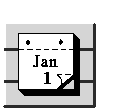
Calendar combines the functions of a desktop calendar and an
appointment book to help you keep track of your meetings and plan your
time. Calendar lets you look at the display for a full year or month
and also to review your scheduled appointments a day at a time.
You can create several different calendars to use for specific
purposes. For example, you can create one calendar to keep track of
your personal engagements and another calendar to schedule conference
room reservations.
This chapter describes how to
- Start Calendar
- Move around within Calendar displays
- Create, modify, and delete timeslot entries
- Use the clock
- Enter day notes
- Mark special days
- Work with multiple calendars
- Customize your calendar
- Integrate your Calendar use with other applications
- Exit Calendar
Starting Calendar
To start Calendar, choose Calendar from the Session Manager's
Applications menu.
By default, the month display appears on your screen.
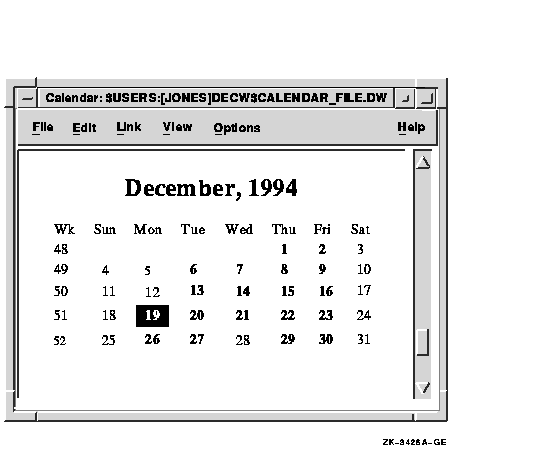 The month display shows the current month and year, with the days of
the month arranged in weekly rows. The current day has a box
surrounding it.
The month display shows the current month and year, with the days of
the month arranged in weekly rows. The current day has a box
surrounding it.
Moving Around in Calendar Displays

Calendar has three main displays: month, day, and year. You can use the
following techniques to move among and within displays:
- Double click on a day or year number or a month name to move from
one display to another. For example, double click on a day number in a
month display to change the calendar window to a display of the
selected day; or double click on the year number in a day display to
change the window into a calendar of the current year.
- Use vertical or horizontal scroll bars to move backward and forward
within a display. For example, in the day display you can use the bar
under the months or the bar to the right of the timeslots.
- Use the View menu to display a selected item, the day display for
today, or the specified type of display (month, day, year).
Creating a Timeslot Entry
The day display shows the timeslots for that day. You can type entries,
such as appointments, directly into the timeslots; or you can use the
entry editor to type longer entries and specify other options, such as
alarms to remind yourself of appointments.
To record a short entry directly into a timeslot:
- Display the day in which you want to make the entry.
- Click (and drag to expand, if necessary) on the desired timeslot.
- Enter the text in the timeslot.
- Click in the highlighted area at the left of the timeslot (where
the times are displayed). This action completes the timeslot entry.
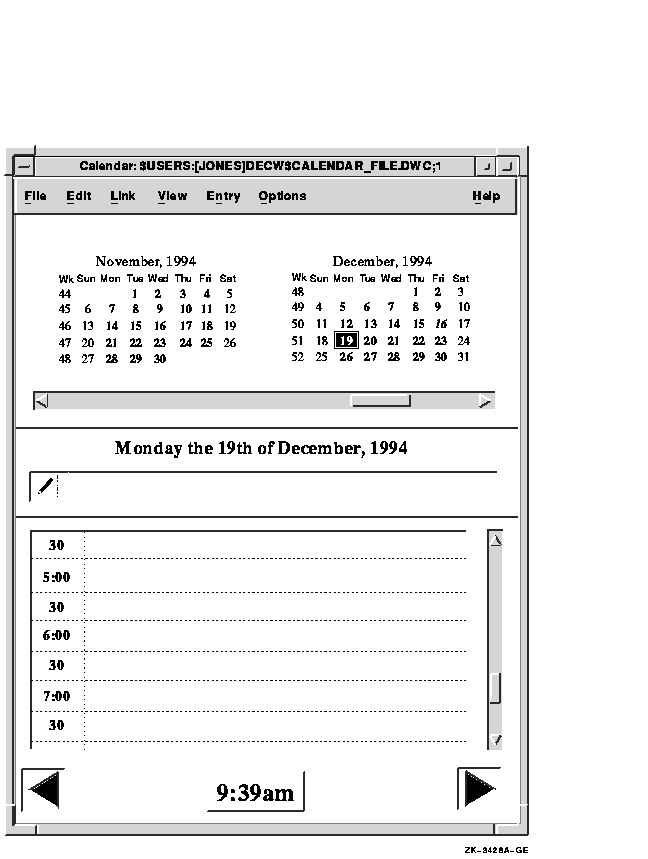
When a day has at least one entry in it, its day number changes from a
normal font (nn) to an italic font (nn) wherever it is
displayed. On a color workstation, the day number for days with entries
appears in blue. You can then distinguish between days containing
appointments and free days in the month and year displays.
To create a long entry or to specify options for the entry, use the
timeslot entry editor:
- Double click on the desired timeslot in the day display.
The
Entry Editor dialog box is displayed.
- Enter the text. You can use the Tab key, the space bar, the Return
key, and the arrow keys to format the text.
- Adjust the alarms and repeat intervals as required (see
Setting Alarms).
- If you wish, click on icons to add or remove them from the entry
display.
These icons are symbols that act as reminders for the
contents of the entry. Calendar attaches no particular meaning to them.
The icons you select appear in the handle of your
entry. The handle is the area between the timeslot time and the two
resize knobs (small squares connected by a thin vertical line).
- Click on OK to confirm the entry and to dismiss the Entry Editor.
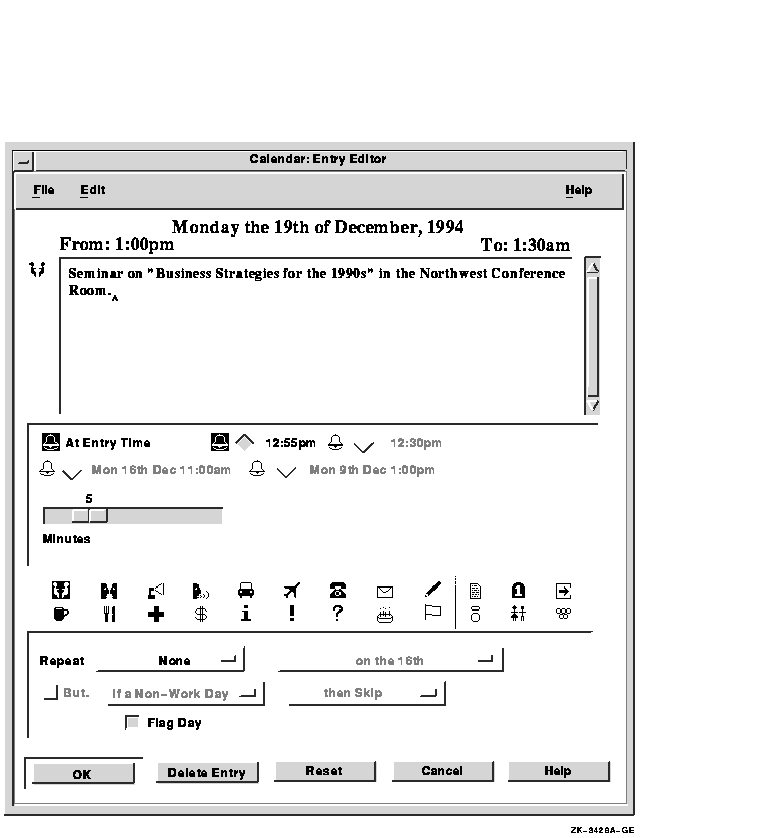
If you exit the editor without entering any text, or if you delete all
the text describing a previous entry, the timeslot remains unscheduled.
Changing the Size of a Timeslot
To enlarge or reduce a timeslot:
- Select the timeslot.
- Press and hold MB2 on the top or bottom resize knob (located
between the handle and the entry text).
- Drag MB2 down or up, depending on whether you want to extend the
appointment later or earlier. The timeslot is redrawn to the new size.
If you reduce the size of a timeslot, some text may no longer fit in
the display, but it is not lost. The text reappears when you expand the
timeslot again.
Setting Alarms
By default, when you type an appointment entry in the Entry Editor,
alarms sound and a message is displayed 5 minutes before the
appointment and at the time of the appointment. You can disable these
options by clicking on them.
You can set alarms to sound at any combination of the following times:
- At the time of the scheduled appointment (this is on by default)
- 1 to 15 minutes in advance (this is on by default, with 5 minutes
as the preset option)
- 1 to 60 minutes in advance
- 1 to 24 hours in advance
- 1 to 14 days in advance
To set one or more alarms:
- Double click on the desired timeslot in the day display.
The
Entry Editor is displayed.
- Enter the text the entry if you have not already done so.
- Click on the bell of the alarm you want to set.
The scale
adjusts to provide the correct intervals for the alarm.
- Move the arrow in the scale to adjust to the time you want.
- Click on OK to save the settings and to dismiss the Entry Editor
dialog box.
You can also modify the default intervals for all alarms by choosing
Alarms... from the Options menu and making the desired changes in the
Alarms dialog box.
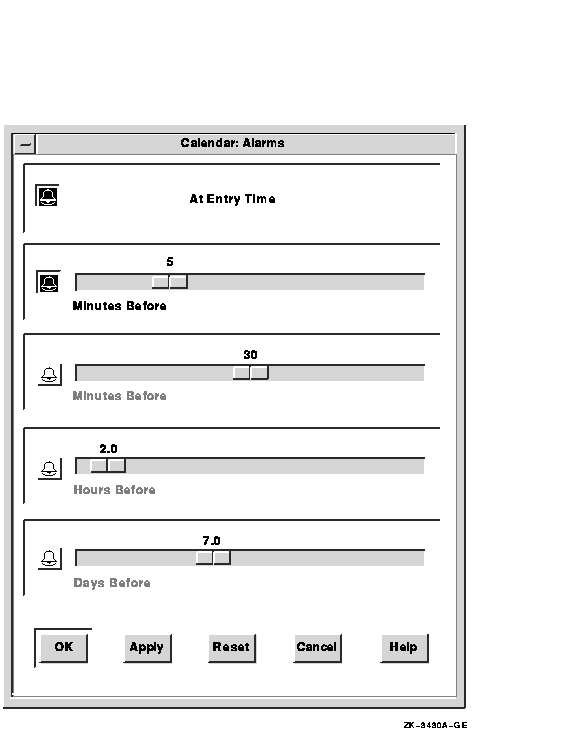
By clicking on the appropriate bell and moving the slider in the slider
bar, you can set alarms up to 14 days in advance and adjust the number
of minutes and hours the alarms sound before an entry. If you change
the defaults, you can save them for future Calendar sessions by
choosing Save Settings from the Options menu. Choosing Restore Settings
causes Calendar to revert to the previous settings; choosing Use
Defaults causes Calendar to revert to the system defaults.
Setting Repeating Alarms
You can also set alarms to ring at any of the following times by
displaying the Repeat Options menu in the Entry Editor dialog box and
choosing the desired option from the following list:
Daily
Weekly
Every two weeks
Every four weeks
Monthly
Every two months
Every three months
Every four months
Every six months
Annually
Once you choose an option, you can specify when you want the alarm to
sound:
- For the intervals Monthly through Annually, you can specify the
alarm frequency by using the Options menu to the right. For example, if
you specify Monthly and today is Thursday, February 21, you can use the
Options menu to specify whether you want the alarm to repeat on the
21st; 7 days before the month end; on the third Thursday of the month;
or on the first Thursday before, on, or after a specified date.
- For all intervals except None, if you click on the But button, you
can specify that if the day is a work day or nonwork day, you want the
alarm to be skipped, moved forward, or moved backward. (You can specify
work days and nonwork days by choosing General... from the Options
menu.)
If you change or delete an entry that is repeated, a dialog box is
displayed asking whether you want to make the change or deletion in
just this instance, from this point on, or every time, including past
instances.
Deleting an Entry
To delete an entry from the calendar:
- Click on the handle or text area of the entry you want to delete.
- Choose Delete... from the Entry menu.
For a nonrepeating entry,
a warning box is displayed asking whether you really want to delete
this entry.
For a repeating entry, a dialog box is displayed asking
whether you want to delete just this instance, this and all future
instances, or all instances.
- For a nonrepeating entry, click on Yes to delete it.
For a
repeating entry, click on the desired deletion option, then click on OK.
Moving an Entry from One Timeslot to Another
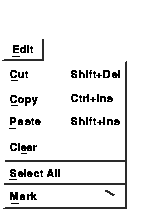
You can copy or move the entire contents of an entry, or just a piece
of text, to another timeslot. If you select the handle, any alarms or
repeat intervals associated with the entry move along with the text to
the new timeslot. If you select the text, only the text moves; neither
the default alarms nor any repetition intervals transfer.
To move or copy an entry:
- Select the handle (for the entire entry) or the text (for the text
only) of the entry to be copied or moved.
- Choose Cut or Copy from the Edit menu. Choosing Cut places the text
in the clipboard and removes the original, whereas choosing Copy makes
a copy of the original and places it in the clipboard.
- Select the timeslot into which you want the entry to be copied or
moved. (If this timeslot is in a different day, select that day display
first.) Resize the timeslot if necessary.
If you want to copy or
move the entire entry to the same timeslot on a different day, you do
not need to display the new day. After you select the day in the month
or year display, choose Paste from the Edit menu. The entry is inserted
into that day, at the same time.
- Choose Paste from the Edit menu. The text appears in the new
location.
To move an entry to a different timeslot on the same day, a quick
method is to press MB2 on the entry's handle or text and drag until you
reach the desired new timeslot.
Creating Overlapping Entries
To create an entry in a timeslot that is partially or completely
occupied by an existing entry, click MB1 or press and drag MB1 to the
start time. Calendar opens a new entry for you at the specified time.
You can overlap as many entries as you like.
By default, overlapping entries are stacked so that the left side of
each entry is always visible. To change the stacking so that you see
the first line of each entry, choose Day View... from the Options menu.
When the Day View dialog box appears, choose Show Text from the
Stacking menu. To view a hidden or overlapped entry, click on its icon;
the entry moves to the top of the stack.
Using the Clock in the Day Display

The clock at the bottom of the day display provides a digital display
of the current time.
When you click MB1 on the clock, the day display returns to the current
day if you have been displaying a different day. Clicking on the clock
also causes the timeslots that are visible in the day display to adjust
so that the first timeslot contains the time in the current increment
that directly precedes the actual time.
For example, if you set the timeslots in the day display at half-hour
intervals and you click on the clock at 10:57, the day display adjusts
so that the first timeslot contains the time 10:30.
This adjustment is continuous; as a timeslot passes, it scrolls off the
top of the display. This scrolling is convenient if you reduce the size
of the day display significantly; only the most immediate timeslots
remain in view.
To stop the automatic scrolling, move the timeslot by any other method,
such as adjusting the scroll bar.
If you are making an entry in a timeslot when it is about to scroll,
the entry does not disappear. The scroll mechanism waits until the next
interval is over, then the mechanism catches up.
The Show AM/PM customizing option (choose General... from the Options
menu) allows you to choose between a 12-hour and a 24-hour time display.
Entering Day Notes
You can enter information in a day note that is specific to a
particular day but is not tied to a particular time. For example, you
can use day notes to identify birthdays and other days of personal
interest.
To enter a brief day note, click on the day note indicator (on the left
side of the box below the date in the day display). Enter the text for
your day note. To complete the entry, click again on the day note
indicator.
To enter a longer day note, double click on the day note indicator to
display the entry editor. You can then enter text, modify an existing
entry, or adjust the alarm settings and repeat intervals.
Marking Special Days
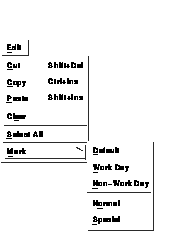
You can mark days of particular importance, such as major project
milestones, holidays, or birthdays. Marking a day alters the display
font of its number in the month and year displays so that you can
distinguish the day from other days in the various Calendar displays.
To mark a day:
- Select the desired day from any of the displays.
- Pull down the Edit menu and display the Mark submenu.
Any items
that already apply to the selected day are dimmed.
- Choose the desired menu item from the Mark submenu:
| Choose |
To Produce |
|
Default
|
The font a day had before it was marked with the Work Day or Non-Work
Day menu item.
|
|
Work Day
|
Bold font.
Once you choose the Work Day menu item, the marked days continue to
display as Work even if you change the setting for that day of the week
to Non-Work in the dialog box of the General... menu item on the
Options menu.
|
|
Non-Work Day
|
Standard Calendar font.
Once you choose the Non-Work Day menu item, the marked days
continue to display as Non-Work even if you change the setting for that
day of the week to Work in the dialog box of the General... menu item
on the Options menu.
|
|
Normal
|
The font in which a day appeared before you marked it with the Special
menu item.
|
|
Special
|
Bold, larger font; on color workstations, displayed in red.
|
Working with Multiple Calendars
You can create, open, save, print, and delete calendars. You can create
different calendars to use for specific purposes. For example, you
could designate one calendar for business appointments and another for
social engagements.
You can use the Open... menu item to open a calendar even if you do not
have privileges to modify it. This feature lets you use a calendar to
share information.
For example, a group secretary can create a calendar for events of
groupwide interest, so that everyone on a team can see when group
activities occur. Only one person at a time can write in this calendar,
and you cannot read the calendar while it is being modified. If no one
is modifying the file, an unlimited number of people can read it
simultaneously. For more information about making a calendar accessible
to a group of people, see your system manager.
Creating a New Calendar
To create a new calendar:
- Choose Open... or Open in New... from the File menu. Open... opens
the calendar in the current Calendar window, whereas Open in New...
opens the calendar in a separate window. Either menu item displays a
File Selection dialog box.
- Enter a unique file name for the new calendar in the Selection
entry box, and click on OK. (On OpenVMS systems, Calendar uses DWC as
the default file type.)
A warning box states that the specified
Calendar file does not exist and asks whether you want to create a new
file.
- Click on Yes to create a new calendar.
By default, the new calendar is presented in a month display containing
the current day.
You can change the calendar file name later if necessary (see
Renaming a Calendar).
Opening an Existing Calendar
To open an existing calendar, follow the steps in the preceding section
(Creating a New Calendar), but specify the name of an existing Calendar file in
the file selection dialog box.
If you specify the name of a calendar that you are not allowed to read,
the Open operation fails and a message box is displayed explaining the
cause of the failure.
Renaming a Calendar
To rename the current calendar, choose Name As... from the File menu. A
dialog box is displayed.
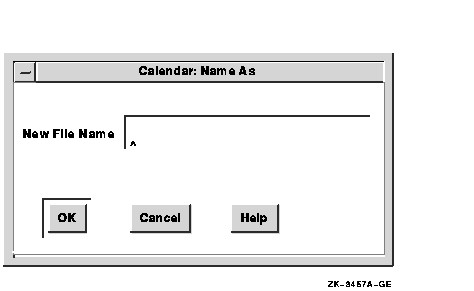
In the text entry box, enter the new calendar name and click on OK. (On
OpenVMS systems, Calendar uses DWC as the default file type.) You can
rename only those calendars in which you are allowed to write.
Closing a Calendar
If you have opened a calendar in a new window (Open in New... from the
File menu), you can close it without exiting Calendar by choosing Close
from the File menu.
If you have not opened the current calendar in a new window, the Close
menu item is dimmed.
Deleting a Calendar
To delete a calendar, choose Delete... from the File menu. Calendar
displays a warning box that asks whether you really want to delete the
calendar. If you do not have sufficient privileges to delete the
specified calendar, an error message is displayed.
Customizing a Calendar
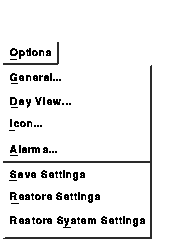
You can specify many options to customize the appearance and behavior
of Calendar displays. These options fall into four categories:
- General options define the work week, the start of the year, and
the behavior of various displays.
- Day View options control the size and content of components of the
day display, as well as other aspects of this display.
- Icon Box options control the content of the icon used when you
minimize the Calendar application. (This control does not pertain to
icons in the day display and Entry Editor; Day View options control
those icons.)
- Alarms options specify the default alarms for timeslot entries.
You can change these options by choosing menu items from the Options
menu. The following sections describe the options. For information
about the alarm option, see Setting Alarms.
Note
The defaults for many options vary depending on the country for which
Calendar is designed. For example, in the American version the default
time display is 12-hour (AM and PM) and the default first day of the
week is Sunday. However, in some other versions the defaults include
24-hour time display and Monday as the first day of the week.
|
Customizing General Features
To customize general features of Calendar, choose General... from the
Options menu.
A dialog box is displayed.
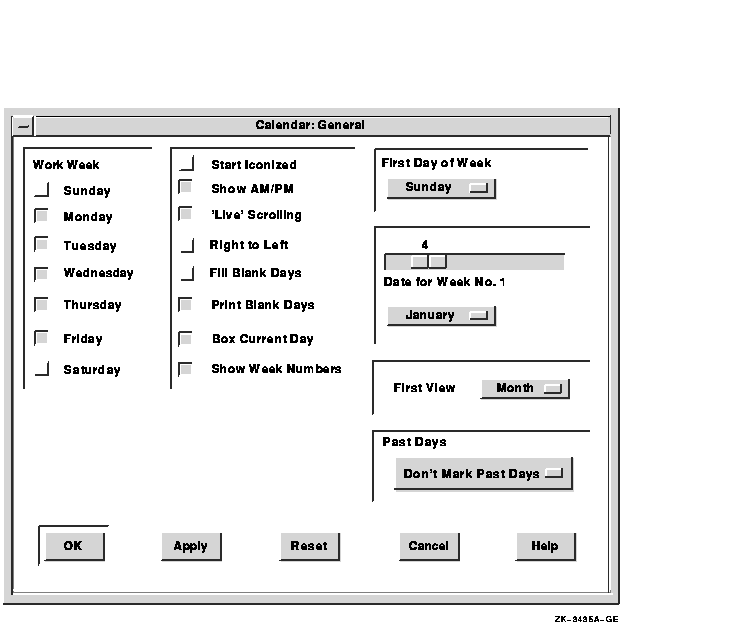
From this dialog box, you can modify any of the following Calendar
options.
Work Week
Use the Work Week settings to identify the standard work days in your
work week.
The check buttons identify work days and nonwork days. The settings
affect the behavior of certain alarm repetition options (for example,
repeat monthly, but if a nonwork day, move the alarm forward to the
next work day).
Start Iconized
If you want Calendar to appear as an icon when it starts, click on the
Start Iconized check button.
Show AM/PM
In its day display, Calendar has either a 12-hour time system, using AM
and PM to differentiate morning and afternoon/evening timeslots, or a
24-hour time system, in which 1:00 PM becomes 13:00, 2:00 PM becomes
14:00, and so on.
For a 12-hour display, enable the Show AM/PM check button; for a
24-hour display, disable the button.
'Live' Scrolling
Normally, when you move the slider on the scroll bars in the day,
month, and year displays, the displays do not move until after you have
moved the slider. When you enable the 'Live' Scrolling check button,
the displays change dynamically when you move the slider.
Right to Left
If you enable the Right to Left check button, the time and day note
indicators and the entry handles appear on the right side of the day
view, and the vertical scroll bar appears on the left side of all
displays.
Fill Blank Days
If you enable the Fill Blank Days check button, any days at the top and
bottom of the month display that are not in the current month appear in
the display. If you disable the check button, these days do not appear.
For example, assume that March 1 is a Friday and March 31 is a Sunday.
If you enable Fill Blank Days, February 24--28 and April 1--6 also
appear (that is, if Sunday is the first day of the week). If you
disable Fill Blank Days, the days from February and April are blank in
the March display.
Print Blank Days
If you enable the Show Week Numbers setting, you can select a week
number and then choose Print... from the File menu to print Calendar
entries for that week.
If you enable Print Blank Days, all days in the selected week print,
whether or not you have entries in them.
If you disable Print Blank Days, days with no entries do not print.
Box Current Day
If you enable the Box Current Day setting, Calendar puts a box around
the current day number.
Show Week Numbers
If you enable the Show Week Numbers setting, the leftmost column in
every month display lists the number of each week in the year.
The date for week 1 is controlled by a separate option in this dialog
box.
First Day of Week
To designate the first day of the week in month displays, display the
Options menu and choose the correct day.
Date for Week No. 1
This option lets you specify the first week of the year. Its effect is
visible if you enable the showing of week numbers,
Use the Date for Week No. 1 option menu to choose the desired month and
use the slider to choose the desired day in that month. For example, if
your fiscal year starts the first week of July and you want to
designate that week as the first week of the year, choose July from the
list of months and choose a day number from the first week. Note,
however, that if you want to increase the probability that the date
always falls in the first full week of the month, you should choose day
6.
First View
Use the First View Options menu to specify whether the day, month, or
year display appears when you start Calendar.
Past Days
Use the Past Days Options menu to determine whether or not past days
are marked and, if so, how:
- Don't Mark Past Days --- no marking
- Strike Out Past Days --- marked with a slash
- Cross Out Past Days --- marked with X
|


